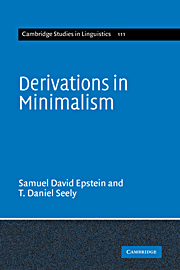5 - Exploring architecture
Published online by Cambridge University Press: 09 October 2009
Summary
Derivational architecture of CHL
In this chapter we explore certain aspects of the derivational model proposed in DASR, the general model being presupposed up to this point. We put in place ‘conceptual’ and technical details that will allow a more complete examination of a range of important data. We are particularly concerned with our hypothesis (some-what different from that in DASR; see below) that LF and PF necessarily evaluate linguistic entities at every point in the derivation. Thus, if X and Y are merged creating C, then C is necessarily input to both LF and PF, which are purely interpretive and interpret as much of C as possible, while C may serve as input to subsequent derivational operations. Explanatory and empirical consequences of this view are considered, with primary focus on certain existential constructions; and more generally, on the nature of ‘violations’ in the syntax; in particular, we show that ‘violation’ has a very different status than in GB. In any phasal system, a violation at one point in a derivation does not necessarily ‘endure’ in later points. Crucially, in our framework, this is different from there being (the GB notion of) ‘repair’ or ‘salvation’. As we will show, the notion of salvation, repair, or ‘overcoming an earlier violation’ are not properties of the step-by-step derivational system that we propose, as we will explain below.
Existentials, Case and the derivation
We begin with a question: Why is there present in a simple existential construction such as (1)?
- Type
- Chapter
- Information
- Derivations in Minimalism , pp. 174 - 198Publisher: Cambridge University PressPrint publication year: 2006

